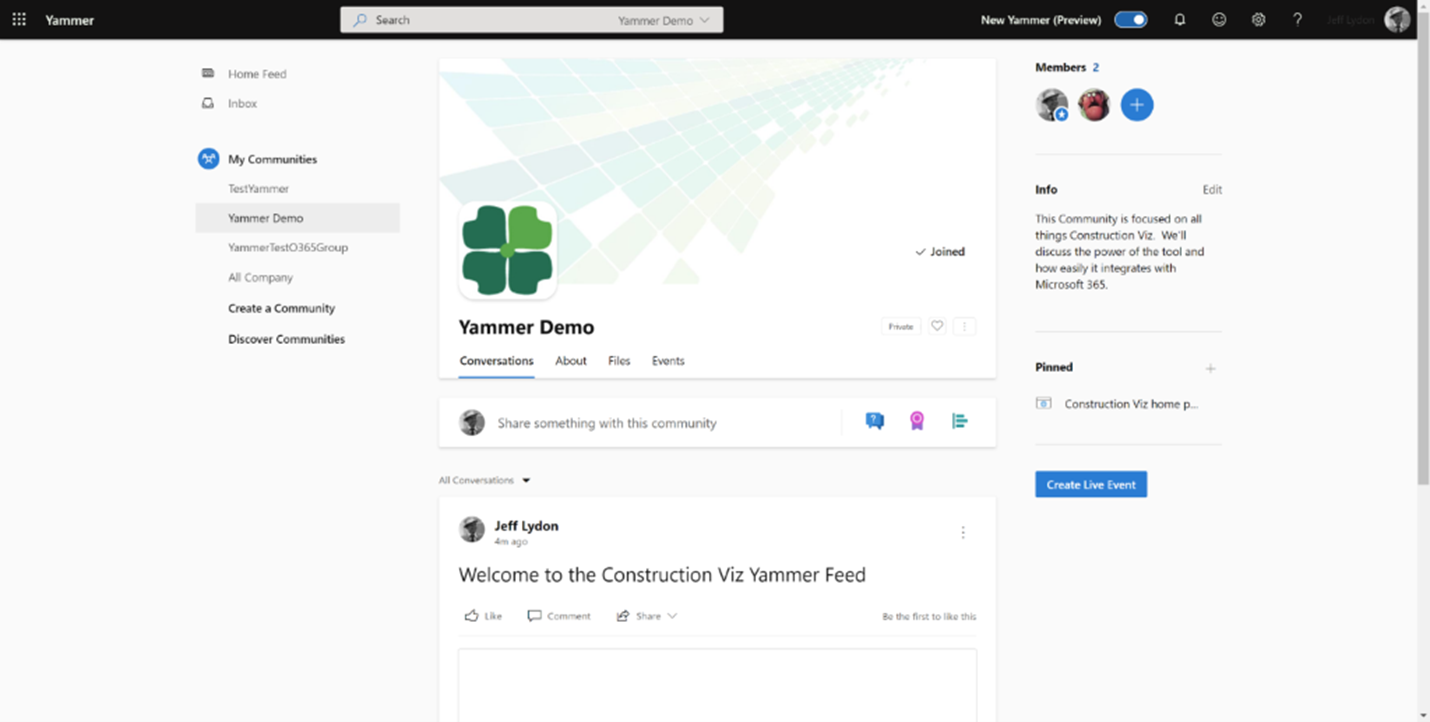Is Microsoft Yammer a Fit for Your Business?
Microsoft Yammer is an enterprise social networking service in Microsoft 365 for internal communications within organizations. Think of it like Facebook, but for your company. Read on to learn more about this communication tool and how you can best use it at your organization.
Microsoft acquired Yammer in 2012 for $1.2B when the frenzy around social media was taking off. The thought was this technology would change how employees would communicate and collaborate across the enterprise. Fast forward eight years, and Microsoft Yammer is still a little-known Microsoft 365 service, at least among construction organizations.
In my opinion, the reason Yammer has not had mass appeal or adoption has nothing to do with the technology lacking. Quite the opposite, the service is very robust and wholly integrated across Microsoft 365. Yammer provides a range of open APIs for integration, many plugins, and options for importing and exporting information. It also offers role-based permissions control as well as to-do lists.
The issue is more with a lack of understanding of what Yammer is and how it differentiates itself from other Microsoft 365 applications. Specifically, two Microsoft acquisitions appear to be in direct competition with Yammer: Skype and Teams.
Microsoft bought Skype in 2011 for $8.5B. Both consumers and businesses use Skype for video and voice calls, as well as instant messaging. Many companies use Skype for Business (the precursor to Teams) as their primary messaging app, perceiving it to be like Yammer conversations (the core feature of Yammer). With the release of Teams, Microsoft is deprecating Skype for Business in favor of this new universal communications app. Teams also includes chat functionality and is fast becoming the “go-to for everything” application in Microsoft 365.
What Are the Best Features of Microsoft Yammer?

Yammer provides an organized way of communicating with your organization as a whole. You can create conversation (chat) groups for team members to participate in addition to private messages. It allows you to share files from SharePoint Online or those uploaded from your computer. You can create questions, polls, announcements, live events, and even publicly praise your group members. It is, in other words, a very well-designed communications tool. But what stands out for me is Yammer’s ability to easily organize, search, and share all these conversations across your organization. It promises to keep engagement high and conversations flowing.
Ideal uses for Yammer include:
- Delivering company training sessions
- Distributing organizational announcements
- Listing lessons learned
- Capturing employee suggestions
For construction organizations specifically, you might want to use Yammer as a project-centric chat application because of its robust search and retention capabilities. You could also take advantage of Yammer as an announcement area for project progress and critical milestones, safety goals, value engineering ideas, safety training, and team-building events.
How Does Yammer Fit into the Future of Microsoft 365?
Teams continues to grow in popularity and reach. More and more functionality that was only in Yammer is starting to make its way into Teams. So could Yammer be wholly absorbed into Teams? I don’t think so because there are some use cases that Yammer addresses that Teams does not. For example, messages in Teams (even public ones) are not searchable or discoverable until you join a team first, making them virtually invisible to non-members. Also, there is no tenant-wide discovery feature for popular or trending conversations in Teams, and even org-wide teams have significant membership limits for many organizations. Not even the new modern SharePoint Communications sites deliver the power of the Yammer conversation model.
I talked about how to select between the various Microsoft 365 collaboration tools in a previous blog post. As I explained, Microsoft structures collaboration in Microsoft 365 around “Loops,” with each application serving a specific communication purpose. If you look at the collaboration applications in Microsoft 365, you can start to see why a user might want to use one tool over the other depending on how you approach your work:
- Content-centric – SharePoint
- Organized team-centric – Teams
- Task-centric – Planner
- Conversation-centric - Yammer
Ultimately, all of these apps could come together into one collaborative platform, like Teams or SharePoint, but Microsoft announced a new Yammer at the end of 2019; it is the most significant update to Yammer since it launched ten years ago.
The new Yammer, now in public preview as of June 2020, boasts a thorough overhaul of the product. Communities replace Groups. The user interface is fresh and uncluttered, and there are plenty of new features too, such as pinned posts, conversations that can be closed, and the ability to push notifications for polls, praise, and question posts. There are revamped mobile apps for iOS and Android and a new app for Microsoft Teams, called Communities, that brings the full Yammer experience into Teams.
I encourage you to try Yammer out and see if it fits with the other applications you are currently using in Microsoft 365.
Do More with Microsoft 365
Lydon Solutions offers a full range of managed services for Microsoft 365, helping organizations implement and take advantage of everything the productivity platform provides.
If you would like a fully featured Project Management Information System (PMIS) that supports Microsoft 365, check out our flexible Construction Viz solution. You can sign up for a no-obligation consultation and demo today.

Related Posts
Struggling to Share SharePoint Files Externally? Here’s the Fix
How the New Copilot Project Manager AI Agent Benefits Construction Scheduling
Construction Document Management and the SharePoint Term Store